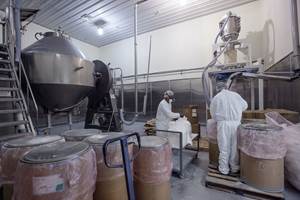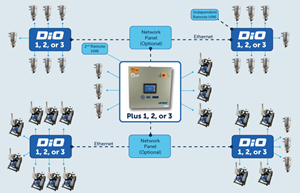Top Ten Myths About Loss-in-Weight Feeders For Compounding Extruders
Loss-in-weight feeders are the most important piece of auxiliary equipment for compounding extruders.
Loss-in-weight feeders are the most important piece of auxiliary equipment for compounding extruders. Feeding errors can not only produce off-spec product and downtime but can also cause machinery damage and personal injury.
If anything, the importance of feeders has grown in the last few years. During this period, twin-screw compounding machinery with higher speed and torque has made it possible to increase productivity by over 100%. These higher-speed machines (over 600 rpm) need loss-in-weight feeders with much better short-term accuracy than in the past. Disturbances in feeding—for instance, during feeder refills—that are tolerable at 400 rpm may not be acceptable at 600 to 1000 rpm. Plastic in a twin-screw compounder running at 1000 rpm has a residence time of only about 1 to 1.5 sec between entering the feed throat and starting to melt. That’s too short a time for a feeder to correct any fluctuation, thus leading to the possibility of a torque surge that could shut down the machine. (Such occurrences have not been uncommon.)
Feeder manufacturers have improved their products to meet the accuracy needs of high-speed compounders. But it’s important that plant engineering and operations staff understand this and other issues when they select and operate a loss-in-weight feeder system. The “system” concept is critical, since processors need both good individual feeders and a good overall feeding system, from the refill mechanism to the extruder, if the compounding line is to operate efficiently.
For proper selection and operation of a loss-in-weight feed system, processors must avoid some prevalent myths about feeders that can lead to endless headaches and lost productivity:
Myth #10
Twin-screw feeders are always more accurate than single screws.
Actually, multi-flight, single- screw feeders have been shown to feed just as accurately over a 1- to 2-sec time frame. Twin-screw feeders are versatile and convey free-flowing powders well, but they have limitations. Shear-sensitive materials can bind up in twin-screws causing erratic flow, material agglomeration in the screw, and possible screw damage. Small, improperly configured twin-screw feeders may jam with pellets or hard granular feedstocks. And replacement screws for a twin-screw feeder cost 50% to 100% more than one for a single-screw feeder.
Myth #9
You should perform some kind of test on a feeder before you buy it.
Running a test is a great way to evaluate feeder performance and the overall capability of the vendor. But just any test won’t do. The test should have a written plan based on your specific objectives and should be run under conditions as close to those of your production as possible. The test should use the same feedstock you use, and the feedstock should be conveyed the same way. Powder that is air-conveyed in dilute phase, for example, flows differently from powder that’s more gently handled, which can have up to 33% higher bulk density.
Be sure to evaluate feeder performance during multiple refills. Also don’t be afraid to give the feeder a whack while it is running to see how it behaves during unplanned disturbances.
Most feeding problems start with the refill system, so the test should mimic the proposed refill system too. Visiting your vendor lets you learn their rules of thumb for equipment set-up, such as how many refills they expect per hour or at what hopper level they expect to start refills. Also, evaluate how often you will need to clean and reconfigure the feeders. Certain pigments and additives require hoppers and feeders made of special plastics or highly polished steel in order to be easily cleanable.
Myth #8
Where you install the feeder on your compounder isn’t that important.
When installing a feeder, look at the environment in which the equipment will operate. Vibration must be minimized. Vent lines for the refill bins and the feeder (essential to prevent choking the system) must not touch equipment on the feeder scale.
You can also be sure someone will drop or ram a feeder sometime during a start-up, when there tends to be lots of activity around a machine. So you must investigate the durability and replacement cost of scale mechanisms. Some are more expensive and harder to get than others.
Myth #7
It’s an engineer’s, not an operator’s, job to specify the feeder control system.
Your instrumentation and control engineers and process engineers should be involved in the selection and planning of the feeder control system, but your lead operators must play part in the detailed design. Engineers often want all the bells and whistles on a control system. That’s fine in principle, but the actual operators should make sure that the screens they will have to work with are clear and logical. Thought must also be given to appropriate security levels for screens (usually three levels: operator, plant maintenance, and engineering). Otherwise your feed system is likely to have a slow start-up because it will be more difficult to debug.
Myth #6
Vibrating loss-in-weight feeders are complicated and not accurate enough.
Newer scale electronics and better control algorithms make vibratory feeders every bit as accurate as screw or belt feeders. For products that are very sensitive to overhandling, like chopped glass fibers, the vibrating hopper, sometimes combined with a slow-turning single screw, is a viable solution. The accuracy of a vibrating feeder handling chopped glass at 330 to 760 lb/hr for a 35% glass-filled nylon 66 compound was recently shown to have a standard deviation of 0.015% over 22 test runs.
Myth #5
Only a loss-in-weight mechanism can feed liquids accurately.
Liquids differ from solids in that their density is constant at a constant temperature and they rarely vary in flowability. A positive-displacement pump can feed almost any liquid with a viscosity of 0.5 to 100,000 cps at ±1% accuracy. Piston or diaphragm pumps work in the 0.5- to 100-cps range. Gear pumps can handle higher viscosities up to 100,000 cps.
If you need to monitor a liquid feed rate, a Coriolis-type meter, which measures flow disturbance, or an integrating scale on the feed reservoir may be used to indicate real-time feed rate and to alarm when it’s outside the target range. But the feedback loop for liquid rate control can often cause more problems than it solves.
Myth #4
It’s the feeder brandthat matters, not the local rep.
The importance of solid technical support within the vendor’s rep network cannot be overestimated. With the need to limit downtime, it is essential that you have a good local rep, who can serve your interests with the feeder manufacturer. Most feeder manufacturers deal with general equipment representatives that sell a variety of equipment. If your local equipment rep is someone who gives you his home phone number and has good contacts at vendor headquarters when you need a favor, stick with that individual. He should also have enough technical savvy that he can help out in your plant if your lead maintenance man needs a hand.
Myth #3
Using a hopper feeder instead of a side feeder can save you money.
Typical side feeders have several items not found on regular hopper feeders for solids, including wear-resistant construction, relatively high-torque screws, fully intermeshing screws, and metal rather than nylon gears for torque transmission. In some cases, solids (hopper) feeders used as side feeders have been destroyed after only three to four days on stream. If the feeder salesman says his solids feeder will function as a side feeder, ask for a written guarantee on its performance and service life.
Myth #2
A volumetric feeder isn’t nearly as accurate as a loss-in-weight one.
A volumetric feeder, well-matched to the material, could perform as well as, or better than, a poorly matched gravimetric one. Gravimetrics are just a mechanism to control and monitor the feeder. They cannot overcome a feeder design that doesn’t consistently move material from the feed hopper to the conveying screw or belt.
Every loss-in-weight feeder should have the ability to run in volumetric mode to let you track actual weight loss over time. When evaluating different feeding systems—for example, a vibratory feeder vs. a screw feeder—examine the accuracy of each feeder in volumetric mode to see the inherent accuracy of the feeding mechanism, separate from the ability of the gravimetric controls to dampen system instabilities. Controls can be tweaked in the field to improve performance to a certain extent, but the wrong feeder design for the material will still require modification or possibly even replacement with a different model.
Myth #1
If the feeder display says the feeder is running at ±1% accuracy, everything’s okay.
Keep in mind how feeder rate is calculated. The displayed rate is an average of the loss in weight of the hopper over a certain time span. The longer this time span, the more the displayed value tends to smooth over any short-term fluctuations. If your line is running at over 600 rpm, you can’t ignore short-term fluctuations, even if your data-collection device does.
The easiest way to see if the feeder is on the money is to look at the Drive Command, which shows motor rpm for a screw feeder or belt speed for a belt feeder. If the Drive Command is fluctuating ±5% and the display says the feed rate is ±1%, the algorithm for calculating the feed rate is hiding short-term fluctuations.
Related Content
Cut Loading Time Through Direct Charge Blending
Direct charge blender loading, a vacuum-powered automation process, can dramatically improve loading time and reduce material costs. In this article, we address ten common questions to help you determine if the systems are right for your facility.
Read More‘Digitalization’ – Awkward Term for a Vital Concept
At K 2022, 85 machines from 40 companies showed off their Industry 4.0 capabilities via OPC-UA interface. A new universal interface for Material Supply Systems was revealed at the show.
Read MoreConveyor Controller Ideal for Expanding Plants
Billed as the most flexible and reliable discrete wired conveying controller on the market.
Read MoreFinding Efficiencies in How Components Work Together
Auxiliary systems are vital to the proper functioning of a plastic processing line, and they can be a source of major cost and efficiency improvements.
Read MoreRead Next
For PLASTICS' CEO Seaholm, NPE to Shine Light on Sustainability Successes
With advocacy, communication and sustainability as three main pillars, Seaholm leads a trade association to NPE that ‘is more active today than we have ever been.’
Read MoreBeyond Prototypes: 8 Ways the Plastics Industry Is Using 3D Printing
Plastics processors are finding applications for 3D printing around the plant and across the supply chain. Here are 8 examples to look for at NPE2024.
Read More












